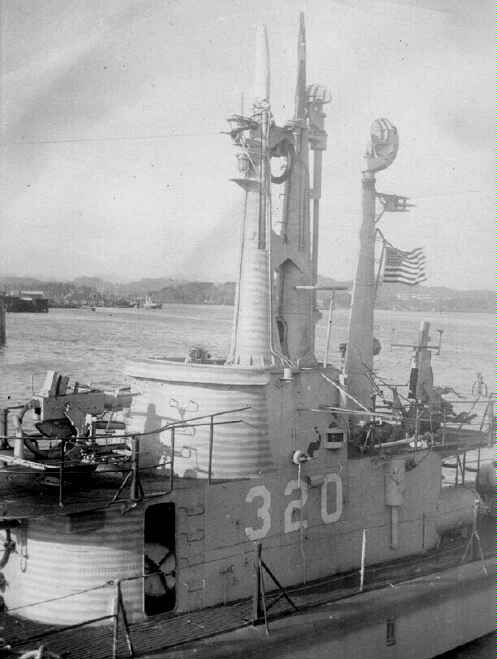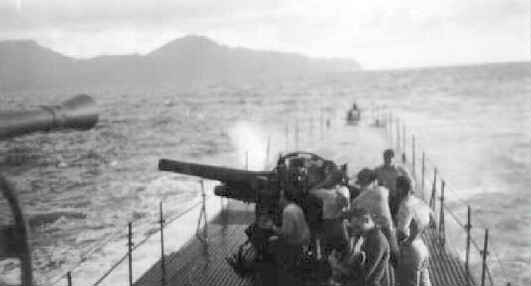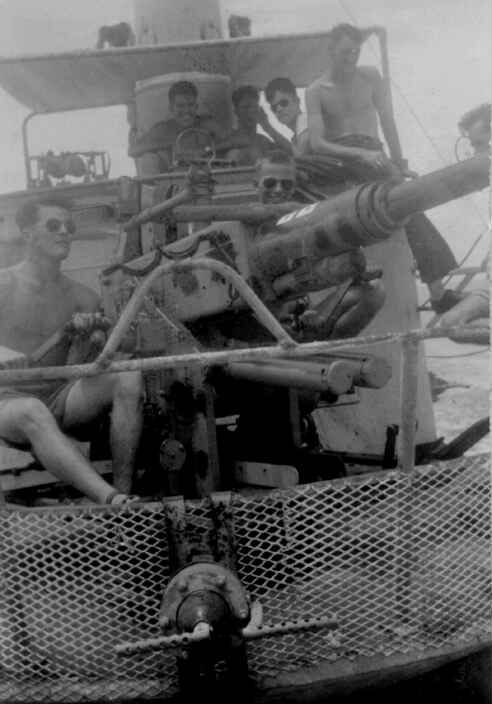
On to War
Patrol #1.
Back to the
SS 320 home page
Deck Guns during the war
Later in the war, larger enemy ships were getting VERY rare. Most had been sunk or damaged. In an effort to keep their supply lines open, the Japanese relied on patrol boats, sampans and small cargo craft, which were busy hauling the precious supplies between the islands. In being prepared for war (mid 1944) the Bergall was outfitted with a 5 inch / 25 caliber gun on the aft deck and 40mm guns on the fore and aft cigarette decks.
Most boats maintained only one 5-inch or smaller gun, normally on the aft deck. Upon entering the war zone, commanders were offered the addition of a forward gun. Heading to Pearl Harbor, to get into the war, the Bergall had target practice against the vertical cliffs of an island near Panama. The men shot so poorly that Hyde, not being terribly impressed with their accuracy, told the base staff in Pearl that he didn't want a second gun and would prefer if they got rid of the aft one!!! Knowing targets for torpedoes were getting scarce, she went to war with the aft 5" anyway.
The mighty 5" / 25 Cal. Deckgun

Here's the 5 inch sounding her deep voice... Cick
This was the first American submarine deck gun designed specifically for
submarines, and proved the most effective because of this. The short
barrel improved accuracy on a submarine's rolling deck, and the five-inch round
was powerful enough to cause serious damage to a target. The first number
is the diameter of the bore, in this case five inches. The second is the length
of the barrel in calibres, with one calibre, in this case, being the bore
diameter of 5". So what 5"/25 indicates is a rifled cannon firing a
5" diameter shell, and with a 125" (10' 5") barrel length. There was a ready locker for the 5" gun,
on the deck, that provided a small, immediately available store of
shells. When those rounds were exhausted ammo was passed up from below the
crew's mess. For the aft 5" gun, on some
boats, there was an ammo hatch
located in the after port side of the crew's mess, through the pressure hull, to
the after 5". There would be a loading party passing ammo from the
magazine, which is below the living deck level to the ammo handlers loading it
through the hatch. The standard procedure was to have a guy drop
down below the crew's mess deck into the ammo locker. He passed ammo up to
guys in the mess who would pass it forward to the Control Room. In the forward
section was access to the gun loading trunk, passing the ammo overhead, up
through the hatch, guys on the deck could reach down through the hatch in the
forward sail and then pass it around the sail and aft to the gun.
The job of passing the ammo up from the ammo locker or from the control room up
through the ammo hatch was the job of the VERY strong. It didn't
take many 65 pound shells being shoved up over your head to wear down even them.

The ammo loading hatch in the sail can be seen with the 40mm guns on the
cigarette deck. The 40mm barrels are being replaced in this refit.
The 5"s had 7X50 binoculars with foam rubber eyepieces with cross hairs in them for the trainer and pointer. The 5"/25 had an effective range of 8000 yards (over 4.5 miles!). The wartime allowance for a standard war patrol was 75 rounds. Her 5" ammo weighed about 65 lbs per unit and usually the stronger men were assigned as loaders. To dive the boat, the gun barrel were secured amidships by a deck-mounted "inverted v" brace and clamp. The fired brass could be sawed off and converted to very large ash trays, during war patrols the brass was cast immediately over the side. The 5" gun was "self ejecting"... just after the projectile was fired, part of the recoil mechanism opened the breach and ejected the spent casing. This ejected at a pretty high speed and weighed quite a few pounds so nobody stood behind the gun and most shells went over the side on their own as they flew out of the breach. Care also had to be observed because at some lower elevations of the gun the ejected shell could bounce off the safety line behind the gun! Prior to the war, nearing Panama, the Bergall went through gunnery practice and in the process the chief gunner was standing near the rear of the gun and the cartridge bounced off the lifeline and hit him in the back and put him out of commission and one of her junior officers was put in charge of the gun.

This is looking aft over the muzzle of the 40mm gun on the cigarette deck to the Bergall's aft 5" and reflects the damage that this gun was designed to deliver. Notice the size and relative weight of the shell as it's hauled aft to the gun! After the war, the 5"/25 cal guns were in abundant supply and the Bergall got a second 5"/25 cal deck gun, mounted forward while in Pearl Harbor and was "ready for hunting bear" if needed. These guns were removed in 1950 when she went through conversion of streamlined sail, removal of handrails and all guns and gun mounts.
Deck Fire Control System and
Organization:
On battle surfacing, the 5"/25 crew comes topside through the conning tower
hatch, drops down to the deck and the loaders open the ready locker to grab the
shells as the rest position on the gun and train on the target. If
the seas allowed, some of the guys could scramble up the ammo loading hatch in
the forward overhead of the control room. The 5"/25 is manned by a gun captain, pointer, trainer, sight
setter, and loader. The gunnery officer takes station in an elevated position in
the periscope shears to direct the gun crew and to spot. The conning tower
relays target range to the gunnery officer via the 7MC circuit. Ranges are
obtained from the radar or the generating TDC on the cigarette deck. The sight setter sets in firing
range and zero deflection angle for the first shot, then sets sights thereafter
in accordance with spots received from the Gunnery Officer. Whistle signals used
in conjunction with securing battle surface stations are:
1 blast = Cease fire,
2 blasts = Secure mount properly and lay below,
3 blasts = Cease fire and lay below immediately without securing the mount.
The boats had internal structures to support a fore and aft mounted deck gun. During the war the Bergall crew mounted a single 20mm on the fore deck and then, later, substituted this for a dual 20mm. These provided a high rate of fire, easily manned and supported with interchangeable barrels. They did not have to drag the barrels for the 20mm up to the cigarette deck, they were stored in ready lockers mounted into the Conning Tower 'shears'. One reason the 20mm was so popular was that you could change the barrel when it got too hot. The replacement barrel just 'shove\snapped' in place. You always carried spares. She came home from the war with the twin 20mm mount up front.
The 40mm Gun
On the fore and aft cigarette deck, the Bergall had 40mm guns. These were all called "wet" guns because they were designed to be locked down in place when the Bergall dove and were made of monel, a type of stainless steel very resistant to salt water and long immersion. The guns were still treated with liberal coats of grease to prevent salt water corrosion while under water. The two single 40mm's were of the same manufacture and were fired by the trainer by means of a foot pedal. They were top loading, bottom ejecting and fired about 90 rounds per minute. They were secured by lashing the barrel to the railing. The 40mm ammo was about 18" long and was in 4 round clips that were fed to the 40's. The 40's were full automatic and as such would fire as long as the foot pedal was depressed and ammo supplied although the fire rate was so slow that single round could be discharged by tapping the pedal with one's foot. Some of the 40mm empty brass was cut off about 4" from the base except for a narrow strip about 3" long. This 3" strip was then bent to a "U" shape to make a small ash tray to hang on one's bunk.
She also had 30cal BMG's (Browning Machine Guns) stored both below decks and on the bridge in the ready (water proof) lockers. The .30 cal BMG was mounted to the bridge railing by means of a spindle and fired the standard 30-06 cartridge (same as an M1 rifle). The amount of 30cals that she carried was often dictated by what the crew could 'liberate' from their home port. The Bergall also carried 6 .45 cal Thompsons, 12 .45 M1911A1 semiautomatic pistols and 6 M1 Garand rifles, a .22 cal rifle and a 45-70 line throwing gun for heaving the heavy mooring lines when returning to port.

Here is one of her 40's with two "Rising Sun" flags on the barrel designating the damage done by that gun at that time. Manning the gun is George Marquis and Joe Nowak, Lt. Welch is on the bridge with his back to the periscope shears. The guy with sun glasses on the bridge is Mort Soiett.
(From personal accounts by shipmates)
On to War
Patrol #1.
Back to the
SS 320 home page